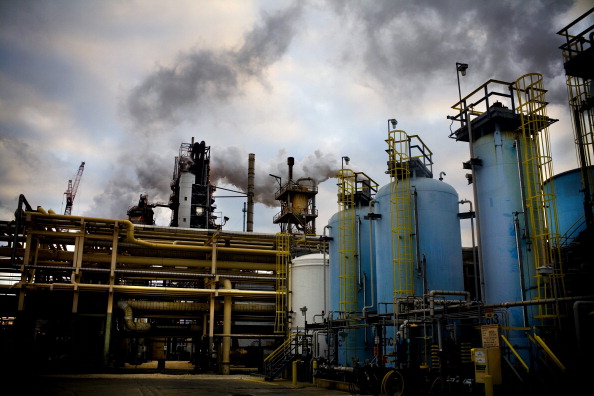As the heavy rainfall of Hurricane Harvey thundered down on the Texas Gulf Coast at the end of August 2017, the roof on a massive ExxonMobil storage tank “partially sank.” The collapse caused the facility to release more than 185,000 pounds of pollutants, including carcinogenic compounds like benzene. That same week, Harvey damaged storage tanks at eight other similar facilities.
Petrochemical storage tanks often have floating roofs that sit right above the product, and the unusually heavy rainfall caused tank roofs to sink, partially submerge, or float and release their contents into floodwaters. In total, the storage tanks released 3.1 million of the reported 8.3 million pounds of excess pollution that were emitted during Harvey.
Many of these accidents could have been prevented if the tanks had been designed to account for the heavier rainfall events brought on by climate change, according to a new report by the environmental and consumer rights nonprofit Public Citizen Texas. The report argues that state regulations and industry standards use outdated rainfall data to set minimum thresholds for building storage tanks and other petrochemical equipment. With climate-fueled storms bringing more frequent and heavier rainfall, the facilities are more likely to fail and release toxic chemicals into the air and water, according to the report.
“Natural disasters are being followed by man made chemical disasters,” said Adrian Shelley, Public Citizen’s Texas office director. “If we know of a weakness, then it should be fixed. If these failures happen again, neither industry nor regulators can claim they weren’t warned.”
Extreme weather events on the Gulf Coast are almost always followed by industrial accidents and pollution. Pollution during hurricanes can take several forms. Facilities that choose to shut down in anticipation of a hurricane often release tens of thousands of pounds of emissions as they burn off excess product in the system and wind down operations. Similarly, these facilities release an elevated amount of pollution when they start back up after the rainfall has subsided. Aside from these foreseen emissions, facilities often also face equipment failures of various types. Generators may become submerged and cause power outages. Valves or pipes may break off. And, as was overwhelmingly the case during Harvey, storage tank roofs may sink or be otherwise damaged.
A key cause of such accidents is Texas’ reliance on outdated and inaccurate standards, according to the report. Construction standards in Texas, including those embedded in state statutes and industry handbooks, often rely on definitions of “100-year storms” and “25-year storms.” The former has a 1 percent chance of occurring during any given year, and the latter has a 4 percent chance. State administrative codes refer to Technical Paper 40, a compendium of rainfall frequency published by the Weather Bureau in 1961, to define these storm events.
The problem is that the compendium uses rainfall data from 1938 to 1958, and rainfall patterns of today are very different from those of the 1940s and 1950s. For instance, Hurricane Harvey dropped nearly 20 inches of rain in the first 24 hours, but the paper’s 24-hour rainfall data for Houston tops out at 12 inches.
The Public Citizen report recommends adopting Atlas-14, a set of rainfall data released by the National Oceanographic and Atmospheric Association in 2018, in place of Technical Paper 40. Although Atlas-14 uses data from the 1980s, the rainfall estimates are more accurate than those the state currently uses. It defines 17 inches of rain over 24 hours as a 100-year event and 29.8 inches of rain as a 1,000-year event.
“Texas’ petrochemical industry is unprepared for severe rainfall because our laws and regulations have not kept pace with our new climate reality,” the report concludes. “Updating these definitions is one way to prepare for even more extreme weather resulting from climate change. Just as the National Weather Service has redrawn its maps, it is time for Texas to redefine extreme weather.”



